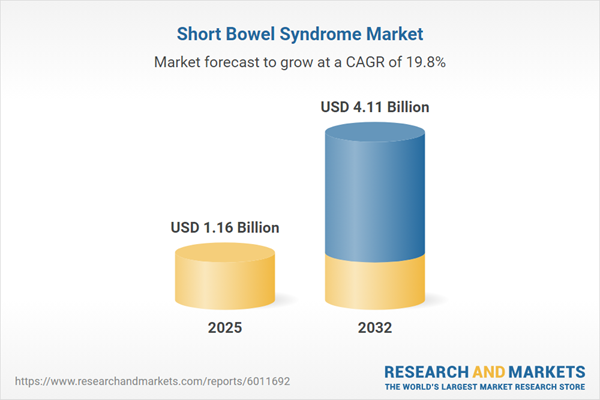Speak directly to the analyst to clarify any post sales queries you may have.
The Short Bowel Syndrome market is evolving rapidly as clinical innovation, operational complexity, and competitive dynamics propel both risk and opportunity for industry leaders.
Market Snapshot: Short Bowel Syndrome Market Size and Growth
The Short Bowel Syndrome market grew from USD 966.42 million in 2024 to USD 1.16 billion in 2025 and is forecasted to reach USD 4.11 billion by 2032, representing a CAGR of 19.84%. With rising clinical need and expanding therapeutic portfolios, healthcare providers and suppliers are adapting to an increasingly diverse and technology-driven landscape while seeking ways to maintain resilience and secure patient access.
Scope & Segmentation
- Treatment Type: Oral Supplementation (Dietary Supplements, Nutritional Formulas); Parenteral Nutrition (Customized PN, Standard PN); Pharmacological Therapy (Antibiotics, Growth Factors, Hormonal Agents); Surgical Intervention (Bowel Transplantation, Intestinal Lengthening Procedures)
- Product Type: Adjunctive Therapies (Probiotics, Vitamins And Minerals); Enteral Formulas (Elemental Formulas, Polymeric Formulas, Semi-elemental Formulas); Pharmacologics (Teduglutide); PN Solutions (Amino Acid Solutions, Carbohydrate Solutions, Lipid Emulsions)
- Route of Administration: Intravenous, Oral
- End Use: Home Care Facilities, Hospitals, Specialty Clinics
- Patient Age: Adult, Geriatric, Pediatric
- Etiology: Congenital Conditions, Crohn Disease, Mesenteric Ischemia
- Regions: Americas (United States, Canada, Mexico, Brazil, Argentina, Chile, Colombia, Peru); Europe, Middle East & Africa (United Kingdom, Germany, France, Russia, Italy, Spain, Netherlands, Sweden, Poland, Switzerland, United Arab Emirates, Saudi Arabia, Qatar, Turkey, Israel, South Africa, Nigeria, Egypt, Kenya); Asia-Pacific (China, India, Japan, Australia, South Korea, Indonesia, Thailand, Malaysia, Singapore, Taiwan)
- Companies: Ajinomoto Co., Inc., Terumo Corporation, Becton, Dickinson and Company, ICU Medical, Inc., Smiths Medical (Smiths Group plc), Otsuka Holdings Co., Ltd., Lonza Group AG, CordenPharma International AG, Gland Pharma Limited, Hikma Pharmaceuticals PLC
Key Takeaways for Short Bowel Syndrome Market Stakeholders
- Integration of next-generation biologics and regenerative medicine is redefining treatment for malabsorption disorders, driving the shift away from traditional parenteral nutrition reliance.
- Patient advocacy and collaboration between care providers, payers, and manufacturers are fostering personalized care models and accelerating access to innovative therapies.
- Strategic alliances, including public-private partnerships and localized manufacturing, are strengthening supply chain resilience amid policy and tariff changes.
- Distinct regional variances influence adoption rates, reimbursement policies, and care delivery strategies, with Asia-Pacific demonstrating rapid biosimilar uptake and localized production, and Western regions prioritizing value-based care.
- Demographic and etiological nuances highlight unmet needs among pediatric and geriatric populations, requiring differentiated product development and multidisciplinary approaches to improve outcomes.
- Emerging biotechs utilizing orphan drug designations and targeted regulatory pathways are broadening the pipeline and reshaping competitive positioning.
Tariff Impact on Supply Chains and Market Access
Recent U.S. tariff adjustments have increased procurement costs for specialized nutritional products, prompting healthcare organizations to review sourcing strategies and favor domestic or regional manufacturing partnerships. These adjustments have led to changes in pricing dynamics and a reassessment of care protocols to sustain efficient treatment delivery, while simultaneously encouraging enhanced supply chain diversification and resilience across the sector.
Methodology & Data Sources
This market analysis synthesizes insights from qualitative interviews with clinical stakeholders, dietitians, and hospital pharmacists, alongside secondary research of peer-reviewed literature, regulatory documents, and clinical trial data. Data triangulation and competitive intelligence were employed to validate trends, with geographic differences contextualized by policy documents and expenditure reports.
Why This Report Matters
- Enables senior decision-makers to identify emerging growth opportunities, technology investments, and risk mitigation strategies tailored to the evolving Short Bowel Syndrome ecosystem.
- Provides nuanced insights into regional market shifts, helping organizations optimize market entry and long-term deployment plans.
- Facilitates evidence-based planning by mapping product, therapy, and demographic trends with actionable recommendations for both established and emerging players.
Conclusion
This report delivers a clear, strategic assessment of the Short Bowel Syndrome market, equipping stakeholders to navigate complexity, align with regulatory trends, and pursue growth through collaborative innovation and specialized solutions.
Additional Product Information:
- Purchase of this report includes 1 year online access with quarterly updates.
- This report can be updated on request. Please contact our Customer Experience team using the Ask a Question widget on our website.
Table of Contents
3. Executive Summary
4. Market Overview
7. Cumulative Impact of Artificial Intelligence 2025
Companies Mentioned
The companies profiled in this Short Bowel Syndrome market report include:- Ajinomoto Co., Inc.
- Terumo Corporation
- Becton, Dickinson and Company
- ICU Medical, Inc.
- Smiths Medical (Smiths Group plc)
- Otsuka Holdings Co., Ltd.
- Lonza Group AG
- CordenPharma International AG
- Gland Pharma Limited
- Hikma Pharmaceuticals PLC
Table Information
| Report Attribute | Details |
|---|---|
| No. of Pages | 199 |
| Published | November 2025 |
| Forecast Period | 2025 - 2032 |
| Estimated Market Value ( USD | $ 1.16 Billion |
| Forecasted Market Value ( USD | $ 4.11 Billion |
| Compound Annual Growth Rate | 19.8% |
| Regions Covered | Global |
| No. of Companies Mentioned | 11 |









